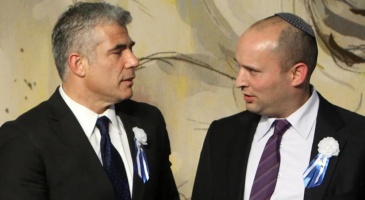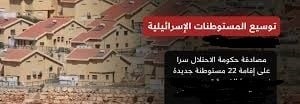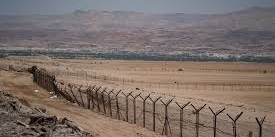By: Madeeha Al-A’raj
The National Bureau for defending land and resisting settlements ( nbprs ) stated in its latest weekly report , that in his first television interview with the Israeli Channel 12, Naftali Bennett, the upcoming Israeli prime minister confirmed that his government won’t freeze construction in settlements in the West Bank. He expects that his government would be subject to American pressure on settlements in the West Bank; however, he said that he would not stop settlement construction. It is worth mentioning here that the agreements that were formulated between the Zionist center and right-wing parties in this government, such as the Yesh Atid parties and the Yemina parties and Tikva Hadasha has clearly stipulated the formation of a monitoring body to maintain Area C in the occupied West Bank, in addition to expanding what it calls heritage sites, and approving 300,000 housing units without specifying the locations of these projects.
For its part, the occupation municipality in occupied Jerusalem, the so-called “Nature Authority”, the Israeli Ministry of Religions and Settlement Associations revived “13” projects in the occupied East Jerusalem, most of which in the vicinity of the Old City related to the expansion of existing tunnels in the area south of Al-Aqsa Mosque and in the Umayyad palaces, and building bridges and biblical passages in the so-called “holy basin”, which were approved during the years 2019, 2020, 2021.
Financial budgets have been allocated to each of them, with the exception of the bridge that extends from the Jewish cemetery in Al-Tur to the endowment lands in Silwan, worth NIS 90 million, according to an amended plan that includes parts of the Bab Al-Rahma cemetery. It was supposed to actually start implementing the project at the beginning of last May, but the recent events in Jerusalem and the Israeli aggression on the Gaza Strip led to the postponement of its implementation.
The occupation municipality has drawn up all the engineering plans and maps, and the area was inspected by engineers in preparation for starting work on the project, preparing the infrastructure for that, and erecting columns. The bridge is 350 meters long and 35 meters above the ground. It will be built over the Kidron Valley, which the occupation authorities confiscated 100 acres of land in favor of the bridge. The bridge would link the Jewish cemetery on the Mount of Olives and Ras al-Amud, all the way to the main street leading to the town of Silwan near the Umayyad palaces.
Israeli sources revealed an Israeli plan to replace the existing reality in Jerusalem through a large-scale construction project at a cost of NIS 70 million that includes the establishment of a spacious urban neighborhood, improving squares, and providing light shows that are broadcast there. In the first phase, the area of the Electricity Company in Salah El-Din Street will be improved, as the infrastructure and building facades will be improved. Moshe Lion, mayor of the occupation in Jerusalem, claimed that this initiative aims to strengthen relations with the residents of East Jerusalem, develop infrastructure, commercial life and employment in the area, with the aim of improving the lives of the residents.
Moreover, the policy of displacement continues in Jerusalem, where the “Net” company, one of the largest tourism and hotel companies in the occupied city faces the threat of eviction from its building and an adjacent land with an area of 8 dunums in the Sheikh Jarrah neighborhood in the latest series of evacuation and settlement in the neighborhood. The building is located near the land of the Mufti in the neighborhood and opposite the house of the former Mufti of Jerusalem Haj Amin Al-Husseini, where the “Atirat Cohanim” Settlement Association established a settlement of more than 24 settlement units, and more apartments are being built on it. The Aterat Cohanim Association says in one of the documents it sent to the Israeli municipality that the owner of the company, Sami Abu Dayeh, is a capable man and has lawyers who threaten what we are planning, and therefore we must expedite the eviction process, while Abu Dayyeh warns against the Israeli authorities evacuating his company from the building and the land adjacent to it, which is part of a 39 dunums, most of which was confiscated by the Israeli authorities.
At the same time, the so-called settlement sub-committee announced the deposit of a detailed structural plan for the settlement of Ma’ale Michmas, which was built on the lands of the village Dir Dibwan on an area of 800 dunums to establish a new settlement neighborhood in the settlement by the year 2040. The same committee also announced the deposit of the detailed structural plan n 3/237 of the “Eli” settlement built on the lands of the village Qariot in the Nablus Governorate in the well-known site Jabal al-Rahut on an area of 403.5 dunums for the establishment of 628 settlement units, buildings and public institutions. Meanwhile, the Local Committee for Planning and Building in the occupation Jerusalem Municipality announced the approval of a detailed structural plan project for the settlement Jabal Abu Ghneim, the western region, to establish 540 housing units consisting of 3 residential buildings of 10 floors, besides 2 housing buildings of 30 floors on an area of 27,7 acres.
The occupation authorities also approved the project to extend the tunnel of Street n. 1, which bears the number 0477679-101, and this tunnel is located in the Al-Masara area in occupied East Jerusalem towards the north on an area of 44.8 dunams. The implementation of the detailed structural plan n 10/5/T/130 for the “Burkan” industrial zone, which was built on the lands of the Haris village in the Nablus Governorate, on an area of 262 dunums. Hebrew sources revealed that, in recent weeks, the settlers managed to build more than 40 settlement units inside one of the settlement outposts south of Nablus.
List of Israeli Assaults over the Last Week Documented by the National Bureau:
Jerusalem:
- The Israeli settlers, led by the Minister of Housing, stormed the courtyards of the Al-Aqsa Mosque from the Moroccan Gate.
- Reinvading the Aqsa Mosque a head of reorganizing Flags’ march in the old city of Jerusalem, which was canceled due to local, regional and international pressures.
- Running over a 15-year-old child, Jawad Abbasi, in the Ras Al-Amud neighborhood under the pretext of raising the Palestinian flag on his bicycle, injuring him in both legs.
- Organizing a provocative march from the Morocan neighborhood towards the Batn Al-Hawa neighborhood, and raising racist banners calling for the expelling of the Palestinians.
- Demolishing the historic wall of the Armenian monastery in Jerusalem, to implement the Armenian land lease to the Israeli municipality.
- Demolishing commercial facilities near the Hizma military checkpoint, belonging to Osama Al-Khatib, under the pretext of not having a building permit.
Ramallah:
- Storming the Ni’lin and Deir Qadis towns, handing notices of demolishing of 10 houses despite having legal building permits under the pretext of being close to the barbed wire fence.
- Attacking the farmers and land owners in the Al-Shorfa area, east of the Deir Jarir village, beating them and smashing vehicle windows with stones to prevent them from entering the area.
- Torching about 50 olive trees in the Jabal Al-Alam area in the Ni’lin town, northwest of Ramallah.
Hebron:
- Bulldozing lands in the Ain Al-Betha and Birin, east of Yatta, an area of about 150 dunums to establish a new outpost near a monument erected by the Israeli settlers in the place.
- Storming the citizens lands in the Um Al-Khoos area near the Maghair Al-Ubaid community in the Masafer Yatta, and began bulldozing it to expand the settlement.
- Notifying to demolish a health clinic in the Birin area, east of Yatta, south of Hebron, under the pretext of building without having a permit.
- Attacking the shepherds and attempting to expel them from the Rajm Al-Hamra area in the Swsia village.
- Torching crops in the Tuba area, which also led to the burning of about 100 agricultural bales.
- Storming the Al-Fakhit area east of Yatta, and handing notices of stopping work in two residential rooms, two tents, two health units, a sheep barn, and an agricultural street.
- Attacking a number of citizens in the Jaber neighborhood in the Old City of Hebron, resulted in the injury of a woman and then admitted to hospital.
Bethlehem:
- Forcing a Palestinian citizen to demolish his own house and farm in the Al-Fardis area, east of Bethlehem, otherwise he would be fined under the pretext of not having a building permit.
- Demolishing a residential room in the Al-Fardis area, east of Bethlehem and throwing stones at the Palestinian vehicles.
- Bulldozing 4 dunums and demolishing a water well in the areas of Qurnat Abu Ali and Khirbet Al-Ghazawi in the Al-Qabo area located between the villages of Husan and Wadi Fukin, west of Bethlehem.
Nablus:
- Bulldozing lands near the Za’tara checkpoint, south of Nablus as part of the construction of the Hawara bypass road.
- The injury of Youssef Ahmed Khatatbeh, 40, from Beit Furik in the leg and head, as a result of attacking the Palestinian vehicles with stones on the outskirts of Khirbet Tana, east of Beit Furik, opened fire towards the citizen.
- Storming the archaeological site in the town of Sebastia, north of Nablus, under strict Israeli protection.
Qalqilya:
- Uprooting dozens of olive trees in the village of Jayyous, east of Qalqilya, under the pretext of being under the Israeli sovereignty in a land of about 30 dunums.
- Attacking a farmer in his land in the Khallet Hassan area between the lands of the towns of Senaria, south of Qalqilya, and Bidia, west of Salfeet.
- Storming the Kifl Haris town.
Jordan valley:
- Extending plastic water lines from the “Maskiot” settlement towards the lands of citizens in the Wadi Al-Faw area, south of the Ein Al-Hilweh, with the aim of seizing them.
- Bulldozing lands in the Israeli outpost built on the citizens’ lands in the Khirbet Al-Suwaida in the northern Jordan Valley, using heavy machinery, with the aim of expanding the outpost.
 المكتب الوطني للدفاع عن الارض ومقاومة الاستيطان منظمة التحرير الفلسطينية
المكتب الوطني للدفاع عن الارض ومقاومة الاستيطان منظمة التحرير الفلسطينية




